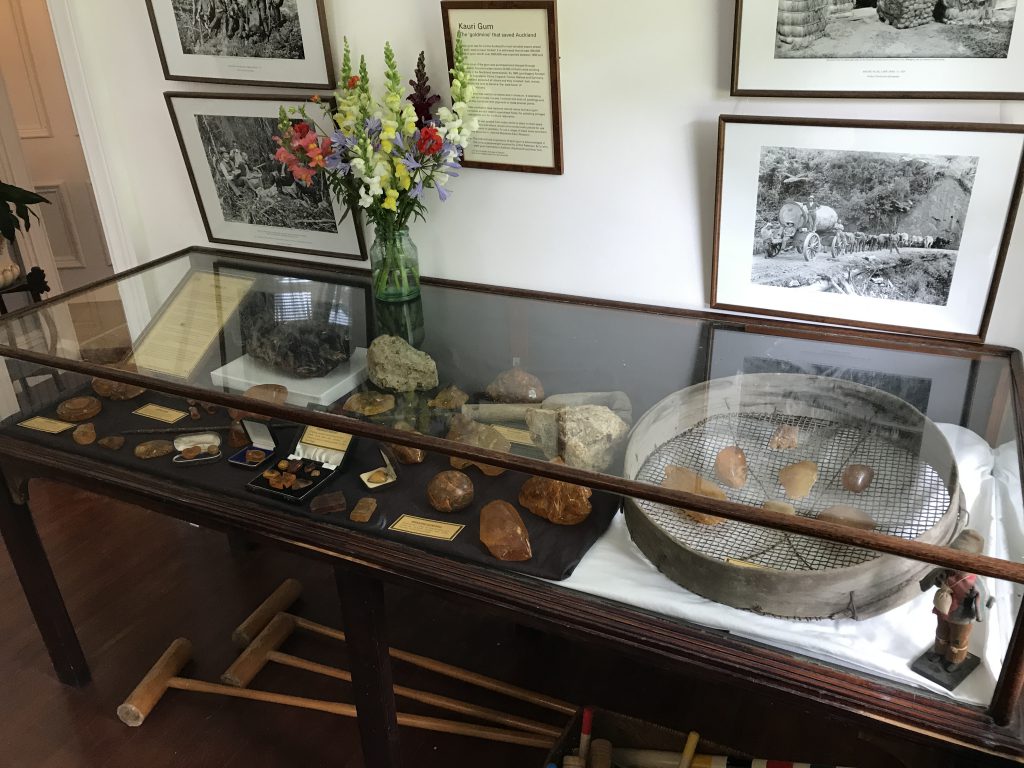
A significant collection of Kauri gum, natural, polished and carved together with associated equipment can be viewed at Cauldrey House, the historic home at Wenderholm, 30 minutes north of Auckland. This is on loan by the Sutcliffe family.
Kauri gum export was the “GOLD MINE” which saved Auckland. While most of the gum was purchased and shipped through Auckland, the huge industry was mostly centred in Northland where late 1800’s nearly 20,000 fortune hunters worked over 800,000 acres of mainly swamp land.
It is estimated that at least 450,000 tons worth over 25 million pounds were exported between 1850 and 1950. It was Auckland’s most valuable export ahead of gold, wool or Kauri timber.
 Kauri gum comes from the sap or resin of the Kauri tree (Agathis Australis), and over hundreds of years dries and hardens. This is very similar to the highly desirable Baltic Amber. The gum found on a living tree was often referred to as candle gum, due to it running or dripping down the trunk. Pieces that are very dark brown verging on black usually have been discoloured through forest or pest fires.
Kauri gum comes from the sap or resin of the Kauri tree (Agathis Australis), and over hundreds of years dries and hardens. This is very similar to the highly desirable Baltic Amber. The gum found on a living tree was often referred to as candle gum, due to it running or dripping down the trunk. Pieces that are very dark brown verging on black usually have been discoloured through forest or pest fires.
By 1880 diggers flooded in from Yugoslavia, China, England, France, Malaya and Germany as well as runaway soldiers from the wars.
The fez wearing Bosnian Dalmatians exceeded all others. What is more, they ploughed back their money into the land and became the back-bone of our wine industry. The two main uses of the resin were in varnishes (both oil based and spirit based) and in linoleum flooring. By the turn of the 20th century, Kauri gum had established itself as the premier varnish resin. It was being brushed on to boats, houses, furniture, and even oil painting, it was also combined with pigments to make enamel paints.
 It was also used to coat the armature windings of electric motors. Today, synthetics have replaced natural resins, but Kauri gum varnishes are still used in specialised fields such as polishing of stringed instruments and furniture restoration.
It was also used to coat the armature windings of electric motors. Today, synthetics have replaced natural resins, but Kauri gum varnishes are still used in specialised fields such as polishing of stringed instruments and furniture restoration.
Kauri gum was graded from water white to virtually black. L.D. Nathan Limited merchants in Auckland, kept a colour graded range of polished gum for buying purposes. This was a most beautiful sight.
In the early day’s diggers and others spent spare time scraping and carving some lovely jewellery and miniature items which also can be seen in this display at Cauldrey House. However the largest collection in New Zealand can be seen at the Matakohe Museum.